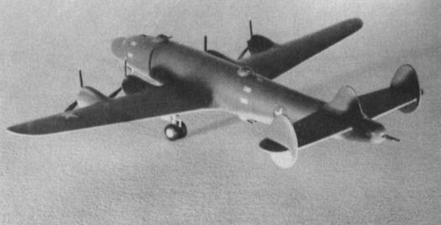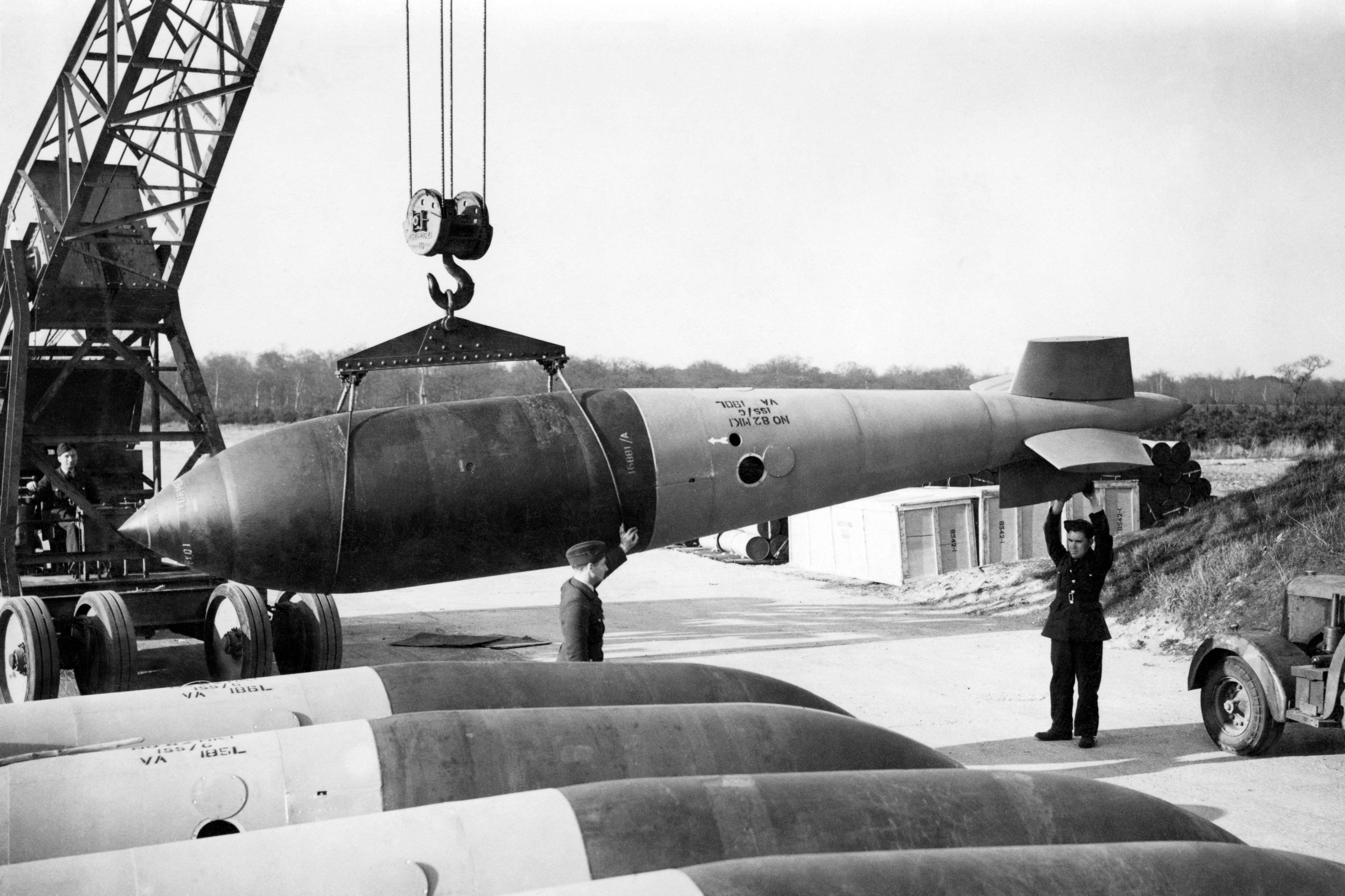This idea for an earlier Washington bomber came about from two directions. I have always been interested in the Rolls Royce Vulture and how it was a near miss but RR had worked out where it went wrong by the time the engine was cancelled. The Vulture is redesigned with RR Merlin sized cylinders and becomes a 3,000 hp 54litre/3300cubic inch engine. The new engine is called the Vulture 100 but is usually known as the Super Vulture.
The second direction I came from was Tube Alloys becomes the British/Canadian Atom bomb programme working on a Uranium Gun bomb whilst the Manhattan Project works on the Plutonium Implosion bomb and the unsuccesful Plutonium Thin Man gun bomb. How to carry this bomb which was thought to be much heavier than it turned out to be, a Lancaster could carry it but would probably be too slow and too low to get away from the blast.
No spare capacity existed in Britain and not enough infrastructure existed in Canada so it was decided that the British Purchasing Commision would see what the big US companies could come up with.
Part 1: January 1940 New York the Anglo/French Purchasing commision is given a most secret order from a secretive organisation called the Committee On Scientific Air Defence who are working on a project called Tube Alloys to ask the big US aircraft companies to propose plans for a new bomber project. The new bomber project called initially Heavy Torpedo Patrol Bomber is given the code name Tin Plate to be consistent with Tube Alloys, codenames meant to be intenionally vague but believable. Tin Plate is an intentionally loose requirement probably fewer than 10 people know what Tube Alloys is and why the Tin Plate project really exists. Only vague ideas of the size and weight of a future bomb exist and it was decided that a plane with 10,000 horsepower capable of an operating altitude of 35,000 feet and a speed of 350mph carrying a 26 foot long and 4 foot diameter Torpedo would be needed. To act as a cover story a torpedo project called Helmover for a giant RR Merlin engined guided torpedo is used as the reason for the design of such a large bomb bay.
The Tin Plate requirement was studied by Douglas, Convair, Lockheed and Boeing. Lockheed and Douglas are simply too busy to put forward plans but Convair and Boeing put forward modified versions of projects they are working on for the USAAC. By 11th May 1940 Boeing have an initial design the model 346 and it is decided Convairs project will not be considered. Boeing is given a contract worth $600,000 to develop the 346. The USAAC is not happy at the Anglo French they think they are trying to horn in on their plane and complain to Washington.
May/June The battle of France rages Tube Alloys and Tin Plate get put on the back burner in London. In Washington the USAAC works on getting the Boeing 346 cancelled. The Anglo/French purchasing commision is disbanded and reformed as the British Purchasing commision taking over all contracts intended for the French.
June 1940 the MAUD Committee is formed
July 1940 the MAUD Committee have a meeting with Churchill. He is told of Tube Alloys and the fears that the Germans have captured some of the French scientists working on the project and must have the same knowledge. It will now be a race to build an Atom Bomb. In Washington the USAAC gets its way and work on the 346 is stopped.
August 1940 The MAUD committee commisions the Canadians to start work on a reactor. Vickers present a design for a Tin Plate bomber but doubt they can even start on work for 2 years without badly delaying designs that are needed now not at some time in the future. A design for a big bomb by one of the Vickers designers Barnes Wallis is marked as of interest and filed for future use.
Boeing is given a contract by the USAAC for 3 prototype 345s to be known as XB-29 but Tin Plate is stuck in a development hell Boeing dont wish to upset its major customer the USAAC but they have a legal contract to develop the 346. A compromise is brought about by the Canadians a new company called Victory Aircraft is set up and the USAAC is told that Victory will be building the 346 whilst Boeing will build the 345. Boeing promises that the 346 project will not slow down the 345 and the USAAC whilst still not happy is told by Washington to can it and get on with it.
January 2nd 1941 with the ink barely dry on the Boeing Victory contract a 4th prototype known as X346 is ordered it is to be built to the USAAC XB-29 designs but will be delivered to Victory aircraft to act as a prototype of what is now to be known as the Washington MkI. This follows the RAF naming of bombers after British Cities but also following the policy of naming US weapons after names that acknwoledge the close ties between the UK and the US.
Helmover it was an absolutely bonkers idea
The idea of the Helmover was that it ran for much of the time on or just under the surface (with a snorkel to provide air to the Rolls Royce Meteor engine), under radio control from the aircraft which had dropped it
Speed was 40 knots (surfaced or submerged) range 50 miles on the surface, three miles submerged. It carried exactly one ton of explosives.

The second direction I came from was Tube Alloys becomes the British/Canadian Atom bomb programme working on a Uranium Gun bomb whilst the Manhattan Project works on the Plutonium Implosion bomb and the unsuccesful Plutonium Thin Man gun bomb. How to carry this bomb which was thought to be much heavier than it turned out to be, a Lancaster could carry it but would probably be too slow and too low to get away from the blast.
No spare capacity existed in Britain and not enough infrastructure existed in Canada so it was decided that the British Purchasing Commision would see what the big US companies could come up with.
Part 1: January 1940 New York the Anglo/French Purchasing commision is given a most secret order from a secretive organisation called the Committee On Scientific Air Defence who are working on a project called Tube Alloys to ask the big US aircraft companies to propose plans for a new bomber project. The new bomber project called initially Heavy Torpedo Patrol Bomber is given the code name Tin Plate to be consistent with Tube Alloys, codenames meant to be intenionally vague but believable. Tin Plate is an intentionally loose requirement probably fewer than 10 people know what Tube Alloys is and why the Tin Plate project really exists. Only vague ideas of the size and weight of a future bomb exist and it was decided that a plane with 10,000 horsepower capable of an operating altitude of 35,000 feet and a speed of 350mph carrying a 26 foot long and 4 foot diameter Torpedo would be needed. To act as a cover story a torpedo project called Helmover for a giant RR Merlin engined guided torpedo is used as the reason for the design of such a large bomb bay.
The Tin Plate requirement was studied by Douglas, Convair, Lockheed and Boeing. Lockheed and Douglas are simply too busy to put forward plans but Convair and Boeing put forward modified versions of projects they are working on for the USAAC. By 11th May 1940 Boeing have an initial design the model 346 and it is decided Convairs project will not be considered. Boeing is given a contract worth $600,000 to develop the 346. The USAAC is not happy at the Anglo French they think they are trying to horn in on their plane and complain to Washington.
May/June The battle of France rages Tube Alloys and Tin Plate get put on the back burner in London. In Washington the USAAC works on getting the Boeing 346 cancelled. The Anglo/French purchasing commision is disbanded and reformed as the British Purchasing commision taking over all contracts intended for the French.
June 1940 the MAUD Committee is formed
July 1940 the MAUD Committee have a meeting with Churchill. He is told of Tube Alloys and the fears that the Germans have captured some of the French scientists working on the project and must have the same knowledge. It will now be a race to build an Atom Bomb. In Washington the USAAC gets its way and work on the 346 is stopped.
August 1940 The MAUD committee commisions the Canadians to start work on a reactor. Vickers present a design for a Tin Plate bomber but doubt they can even start on work for 2 years without badly delaying designs that are needed now not at some time in the future. A design for a big bomb by one of the Vickers designers Barnes Wallis is marked as of interest and filed for future use.
Boeing is given a contract by the USAAC for 3 prototype 345s to be known as XB-29 but Tin Plate is stuck in a development hell Boeing dont wish to upset its major customer the USAAC but they have a legal contract to develop the 346. A compromise is brought about by the Canadians a new company called Victory Aircraft is set up and the USAAC is told that Victory will be building the 346 whilst Boeing will build the 345. Boeing promises that the 346 project will not slow down the 345 and the USAAC whilst still not happy is told by Washington to can it and get on with it.
January 2nd 1941 with the ink barely dry on the Boeing Victory contract a 4th prototype known as X346 is ordered it is to be built to the USAAC XB-29 designs but will be delivered to Victory aircraft to act as a prototype of what is now to be known as the Washington MkI. This follows the RAF naming of bombers after British Cities but also following the policy of naming US weapons after names that acknwoledge the close ties between the UK and the US.
Helmover it was an absolutely bonkers idea
The idea of the Helmover was that it ran for much of the time on or just under the surface (with a snorkel to provide air to the Rolls Royce Meteor engine), under radio control from the aircraft which had dropped it
Speed was 40 knots (surfaced or submerged) range 50 miles on the surface, three miles submerged. It carried exactly one ton of explosives.

Last edited:




